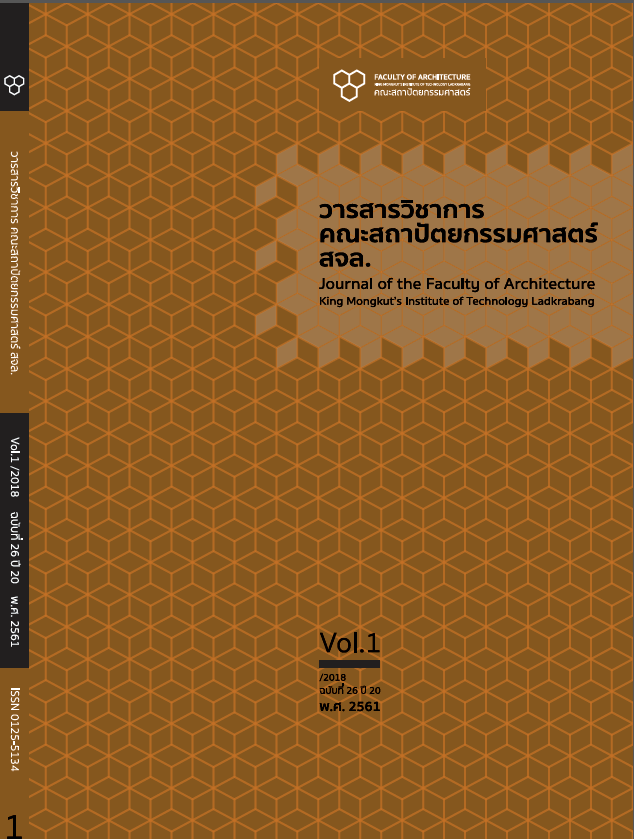การเปลี่ยนผ่านบทบาทพื้นที่สาธารณะของประเทศไทย, The Transition of Roles of Public Spaces in Thailand
Main Article Content
Abstract
Abstract
This study discusses a literature review on public space involving the universal and Thai historical benchmarks for the definition, importance and evolution of land use and lifestyle patterns in national and
global contexts. It purposes to find factors influencing the role of public space in functioning the users and transition of the role of public space utilization of Thai society. The results indicated the relationships
between physical space and users according to the benchmarking. Its characteristics vary along the dynamics of city where the public space exists. The study found main factors that affect the role of public space in serving user including physical characters of public space, users, and social conditions. In addition, the findings illustrated transition of the use of public space in Thailand on various activities from past to present as follows: 1) recreation and social interaction; 2) exchange and trade; 3) belief and religion manifestation; 4) political space for people power; 5) education and learning; 6) quality of life improvement; 7) reflection of user’s social value and status; 8) transportation and connectivity capability; 9) provision of convenience; and 10) landmark and city image. Henceforth, an approach for creation of Thai public spaces should concern users’ lifestyles and activities from past to present in order to provide the maximum utilization for people and city.
Keywords: Public Spaces, Roles of Public Spaces, Transition
Article Details
This work is licensed under a Creative Commons Attribution-NonCommercial-ShareAlike 4.0 International License.
Copyright Transfer Statement
The copyright of this article is transferred to Journal of The Faculty of Architecture King Mongkut's Institute of Technology Ladkrabang with effect if and when the article is accepted for publication. The copyright transfer covers the exclusive right to reproduce and distribute the article, including reprints, translations, photographic reproductions, electronic form (offline, online) or any other reproductions of similar nature.
The author warrants that this contribution is original and that he/she has full power to make this grant. The author signs for and accepts responsibility for releasing this material on behalf of any and all co-authors.
References
https://www.dpt.go.th/ITCitdb/txt/intro.pdf.
กาญจนา แก้วเทพ, กิตติ กันภัย และปาริชาต สถาปิตานนท์ สโรบล. (2543). มองสื่อใหม่ มองสังคมใหม่. กรุงเทพฯ:
เอดิสัน เพรส โพรดักส์.
กาญจนี ละอองศรี (บรรณาธิการ). (2556). ประวัติศาสตร์ไทยฉบับสังเขป เดวิด เค วัยอาจ David K. Wyatt.(2). กรุงเทพฯ:
มูลนิธิโตโยต้าประเทศไทย.
คริส เบเคอร์ และผาสุก พงษ์ไพจิตร. (2557). ประวัติศาสตร์ไทยร่วมสมัย. กรุงเทพฯ:
สำนักพิมพ์มติชน.
จุฬาลงกรณ์มหาวิทยาลัย. (2554). เอกสารประกอบการบรรยายกิจกรรมสรุปเข้มฯ ครั้งที่ 7 “เปิดคลับ ขยับสเตปฝันคนพันธุ์แอดฯ”
วิชาสังคมศึกษา. เข้าถึงได้จาก: file:///C:/Users/Win8.1PRO/Downloads/sk7-so.pdf.
นันทา โชติกะพุกกณะ และนิออน สนิทวงศ์ ณ อยุธยา. (2515). ประวัติศาสตร์โลกฉบับสมบูณ์. โครงการตำราสังคมศาสตร์และ
มนุษยศาสตร์ สมาคมสังคมศาสตร์แห่งประเทศไทย. เข้าถึงได้จาก : https://www.openbase.in.th/files/tbpj154.pdf.
สุธาริน คูณผล. (2541). บทสำรวจพื้นที่สาธารณะ. รัฐศาสตร์สาร. 20(3) (2541), 167-214.
สิงหนาท แสงสีหนาท. (2545). หลักการทางแนวคิดชุมชนเมืองที่ยั่งยืนในบริบทของไทย. (วิทยานิพนธ์สถาปัตยกรรมศาสตร์-
มหาบัณฑิต บัณฑิตวิทยาลัย, มหาวิทยาลัยศิลปากร).
สำนักงานคณะกรรมการพัฒนาการเศรษฐกิจและสังคมแห่งชาติ. (2560). แผนพัฒนาเศรษฐกิจและสังคม. เข้าถึงได้จาก:
https://www.nesdb.go.th/main.php?filename=develop_issue.
Arendt, H. (1998). The Human Condition. Chicago: The University of Chicago Press.
Ben, S.I. and Gaus, G. F. (1983). Public and Private in Social Life. London: Croom Helm.
Bertolini, L and Martin D. (2003). Mobility Environments and Network Cities. Journal of Urban Design. 8(1)(2003),
27-43.
Carmona, M., Tiesdell, S., Heath, T. and Oc, T. (2010). Public Place Urban Space. Oxford: Architectural Press.
Carr, S., Francis, M., Rivitin, L.G. and Stone, A. (1992). Public Space. Cambridge: Cambridge University Press.
Crawford, M. (1999). Blurringthe Boundaries: Public Spaceand Private Life. Retrieved from
https://www.uky.edu/academy/sites/www.uky.edu.academy/files/
Crawford%2C%20Blurring%20the%20Boundaries.pdf.
Davison, G. (1994). “Public Life and Public Space: A Lament for Melbourne City Square”. In Historic Environment.11(1)
(1994), 4-9
Dijkstra, L.W. (2000). Public Spaces: A Comparative Discussion of the Criteria for Public Space. In R.Hutchison (Ed.)
Constructions of Urban Space: Research in Urban Sociology. (pp.1-22). Stamford,
Connecticut: JAI Press.
Francis, M. (1989). Control as a Dimension of Public Space Quality. I. Altman and E.H. Zube (Edited). Public Places and
Spaces. New York : Plenum Press.
Gehl. (2001). Life between Buildings. Retrieved from
https://www.ifhp.org/sites/default/files/field/files_news/Jan%20Gehl_1.pdf.
Goodsell, C.T. (2003). The Concept of Public Space and Its Democratic Manifestations. The American Review of Public
Administration. 33(4) (2003), 361-383.
Habermas. (1989). The Structural Transformation of the Public Sphere: an Inquiry into a Category of Bourgeois Society.
Retrieved from https://courses.ischool.berkeley.edu/i218/s15/Habermas_STBPS_I.Intro.pdf.
Jacobs, J. (1961). The Death and Life of Great American Cities. Retrieved from :
https://www.buurtwijs.nl/sites/default/files/buurtwijs/bestanden/
jane_jacobs_the_death_and_life_of_great_american.pdf.
Lynch, K. (1981). Good City Form. Cambridge London, England: The MIT Press.
Lofland, L.H. (1973). A World of Strangers; Order and Action in Urban Public Space. New York: Basic Books.
Low, S. (2000). On the Plaza: The Politics of Public Space and Culture. Austin: University of Texas Press.
Madanipour, A. (2010). Whose Public Space?. New York: Routledge.
Massey, D. (1998). Power-geometries and the politics of space-time. Heidelberg, Germany: Department of Geography,
University of Heidelberg.
Project for Public Spaces. (2012). Placemaking with Project for Public Spaces. Retrieved from
https://www.pps.org/pdf/pps_brochure.pdf.
Sennett, R. (1992). The Fall of Public Man. New York: W. W. Norton.
Sorkin. (1992). Variations on a Park: The New American City and the End of Public Space. Retrieved from
https://www.ffst.unist.hr/_download/repository/Mike-Davis-Fortress-Los-Angeles-the-Militarization-of-Urban-
Space.pdf.
UN-Habitat. (2015). World Habitat Day: Housing Policies Affordable Homes. Retrieved from
https://urbanoctober.org/downloads/UrbanOctoberBackgroundPaper.pdf.

